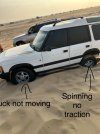hi_arshard
Member
Hello guys,
Could you please give your feedback on the below, I doubt my diff lock is not working as expected,
Got stuck in the sand and wheels spinning without traction (desert sand) diff lock on H-lock Dash lights come on as well.
Spinning wheels with no traction,
Rear left wheel and front Right wheel spinning has no traction.
Stuck wheel with no movement,
Front left wheel and rear right wheels are stuck not moving at well.
Tried with Low -lock as well no luck.
At this point I expect the stuck wheels to gain power so the car will get out.
As per the theory, when the diff is in lock position front / rear axles will have 50/50 power distribution equally and all wheels should be spinning but in my case only one wheel was spinning in each axle and that is the wheels which without traction which is useless.
Refer to the attached picture. sorry couldn’t take much pictures only left side I have.
Thanks and much appreciated
and much appreciated
Arshad
Could you please give your feedback on the below, I doubt my diff lock is not working as expected,
Got stuck in the sand and wheels spinning without traction (desert sand) diff lock on H-lock Dash lights come on as well.
Spinning wheels with no traction,
Rear left wheel and front Right wheel spinning has no traction.
Stuck wheel with no movement,
Front left wheel and rear right wheels are stuck not moving at well.
Tried with Low -lock as well no luck.
At this point I expect the stuck wheels to gain power so the car will get out.
As per the theory, when the diff is in lock position front / rear axles will have 50/50 power distribution equally and all wheels should be spinning but in my case only one wheel was spinning in each axle and that is the wheels which without traction which is useless.
Refer to the attached picture. sorry couldn’t take much pictures only left side I have.
Thanks
Arshad
